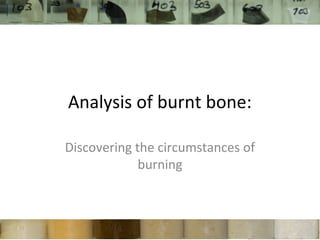Analysis of burnt bone by Alison Nicholson Session 9 2012
•Descargar como PPT, PDF•
2 recomendaciones•1,429 vistas
This document discusses the analysis of burnt bone to determine the circumstances of burning. It outlines several techniques used including: [1] examining bone color and fracture patterns to estimate burning temperature; [2] elemental analysis to detect staining from metals; and [3] other analytical methods to assess the degree of burning. Key factors investigated are temperature, time, presence of other materials, and location of burning to better understand how and why the bones were burnt.
Denunciar
Compartir
Denunciar
Compartir

Recomendados
Recomendados
Roman City dig, session 9, 2012: Nutrition in the Ancient World, by Kristin D...

Roman City dig, session 9, 2012: Nutrition in the Ancient World, by Kristin D...Ecomuseum Cavalleria
Más contenido relacionado
La actualidad más candente
La actualidad más candente (20)
Analysis of illicit liquor including methyl & ethyl alcohol

Analysis of illicit liquor including methyl & ethyl alcohol
Más de Ecomuseum Cavalleria
Roman City dig, session 9, 2012: Nutrition in the Ancient World, by Kristin D...

Roman City dig, session 9, 2012: Nutrition in the Ancient World, by Kristin D...Ecomuseum Cavalleria
Más de Ecomuseum Cavalleria (20)
Roman city dig, session 10, 2012: Late empire Roman coins, by Andrew Walsh

Roman city dig, session 10, 2012: Late empire Roman coins, by Andrew Walsh
Roman City dig, session 9, 2012: Nutrition in the Ancient World, by Kristin D...

Roman City dig, session 9, 2012: Nutrition in the Ancient World, by Kristin D...
Trepanation Presentation by Karrah Christenson Session 8 2012

Trepanation Presentation by Karrah Christenson Session 8 2012
Roman city dig: session 7, 2012: Roman metals, by Geoff Tindall 

Roman city dig: session 7, 2012: Roman metals, by Geoff Tindall
Sesion no. 5, 2012: Early Christian Catacombs, by Suzie Markland

Sesion no. 5, 2012: Early Christian Catacombs, by Suzie Markland
Session no. 4, 2012: Rebecca McKie: Roman villa’s and estates

Session no. 4, 2012: Rebecca McKie: Roman villa’s and estates
The importance of underwater archaeological research

The importance of underwater archaeological research
Cave archaeology and post depositional processes affecting taphonomy session...

Cave archaeology and post depositional processes affecting taphonomy session...
Session no. 3, 2012: Roman Imperial Coins, by Gustavo Trapp 

Session no. 3, 2012: Roman Imperial Coins, by Gustavo Trapp
Analysis of burnt bone by Alison Nicholson Session 9 2012
- 1. Analysis of burnt bone: Discovering the circumstances of burning
- 2. Why study burnt bone Many Uses Use of fire in prehistory, dietary and cooking habits, animal sacrifices, migration and trade in life stock, firing of cities, cannibalism, witch executions and funerary practises 2 Questions • What are the bones? • What are the circumstances of burning?
- 3. What are the Circumstances of burning • Temperature • Time • Soft tissue • Oxidation • Other objects (metals) • Location
- 4. Analysis techniques • Colour • Fracture patterns • Elemental analysis (ICP-MS/XRF) • Other analytical techniques (XRD,FTIR, electron microscopy) • Use of external clues
- 5. Fracturing
- 6. Colour & Temperature Stage Temperature range Colour description Munsell (dominant colour) 1 20-285 °C Neutral white/ pale yellow 5Y 8/2, 10YR 8/4 2 285-525 Reddish brown, dark grey brown, neutral N 2.7 5/0 dark grey, reddish yellow 7.5YR 8/3 3 525-645 Neutral black, medium blue, some reddish 10YR 7/2 yellow 4 645-940 Predominately neutral white, with light N 9/0 blue grey and light grey N9.5/0 5 940+ Neutral white with some medium grey and N9.5/0 reddish-yellow
- 7. Colour & Metals • Characteristic colour for each metal: e.g. • Bronze: Green/Blue • Iron: Red • Zinc: Yellow
- 8. Problems with colour analysis • Secondary change • Many confounding variables
- 9. External clues • The melting of another material with a known or calculable melting point • E.g. Glass melts at 500°C to over 2000°C depending on the type of glass
- 10. Elemental analysis Use: Examples: • Identification of • XRF compounds or elements • ICP-MS • Good at detecting staining- Metals/ minerals • Thermal decomposition
- 11. Other analysis Uses Examples Distinguishing burnt from • XRD unburnt • FTIR Looking at the degree of • Electron Microscopy burning: • Recrystallization • Thermal decomposition Penetration of staining
- 12. XRD NaCaPO4, CaO, MgO 30 40 50 2-Theta - Scale
- 13. Bibliography Shipman, P., Foster, G. and Schoeninger, M. (1984). Burnt Bones and teeth: an experimental study of colour, morphology, crystal structure and shrinkage. Journal of archaeological science, 11, pp.307-325 Harter, R.(2011). Piltdown man. http://home.tiac.net/~cri_a/piltdown/piltdown.html Nicholson, A.(2011). The effect of multiple burning on bone mineral
